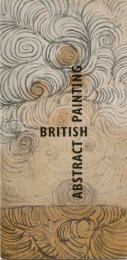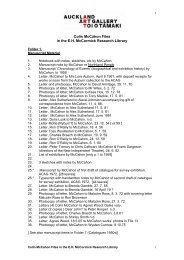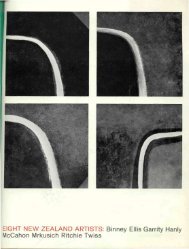You also want an ePaper? Increase the reach of your titles
YUMPU automatically turns print PDFs into web optimized ePapers that Google loves.
Preface / AcknowledgmentsIn 1986 the <strong>Auckland</strong> <strong>Art</strong> <strong>Gallery</strong>, inconjunction with one of its businessunits, the Northern Regional ConservationService (NRCS), published thebook <strong><strong>Art</strong>care</strong>: The Care of Museum and<strong>Art</strong> Collections in New Zealand. Suchwas the immediate success of <strong><strong>Art</strong>care</strong>that it has become long overdue forrevising and reprinting. Now it has beenaccepted as a standard reference withinmuseums throughout the country, anupdated <strong><strong>Art</strong>care</strong>, produced under theexpert guidance of the <strong>Gallery</strong>’s newly establishedConservation Services, seemed more than timely.The first edition of <strong><strong>Art</strong>care</strong> specifically set out toprovide preventive conservation advice to small museums,with particular reference to New Zealand collectionsand conditions. In building awareness of theprimary causes of deterioration and damage to works ofart and artefacts, <strong><strong>Art</strong>care</strong> made a very cost-effective contributionto the preservation of New Zealand’s culturalmaterial in public holdings. It gave staff, from the paidto the non-paid, an essential tool-kit of practical advice.The revised <strong><strong>Art</strong>care</strong> extends its brief further to encompassthe many and varied private collectors who no lesslook to the safe-keeping of our distributed national collection.Preventive conservation is the most direct anduncomplicated way of caring for works of art and artefacts.Not only are conservation treatmentsa sometimes expensive path to godown, they do not always lead to thesuccessful reversal of the cumulativeeffects of deterioration or damage. Inaddressing the practical needs of thoseresponsible for the care or managementof collections, <strong><strong>Art</strong>care</strong> also draws outthe caveats which must limit the natureof that care. It makes clear that damagecan as much be the product ofuntrained or ill-advised attempts to conserveor restore works or objects.The updating of <strong><strong>Art</strong>care</strong> has also been propelled bythe many significant advances in conservation sciencewhich have led to sometimes quite fundamental shifts inthe development of preventive conservation practicesand procedures. There are also, of course, many newsuppliers and reference materials to hand today, andpublic and private collectors are demanding currentinformation to ensure that best preventive conservationpractices are being applied to the works in their permanentor temporary care.In introducing this new edition of <strong><strong>Art</strong>care</strong> I wouldlike to especially thank Sarah Hillary, the <strong>Gallery</strong>’sSenior Conservator, for her unerring dedication to thisnow ongoing project. Sarah has skilfully coordinated thework of many conservators from around the country, towhom the <strong>Gallery</strong> is no less greatly indebted. Their
















